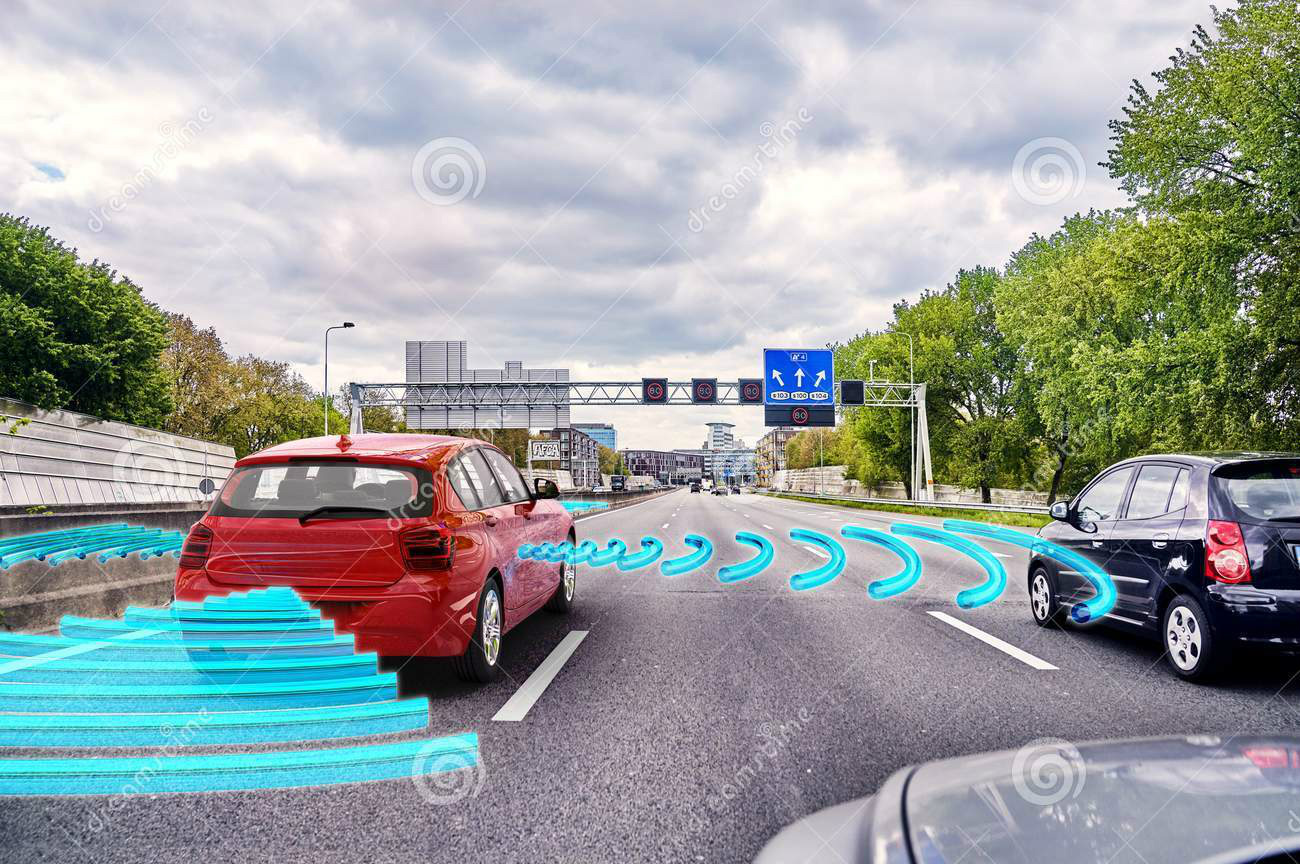By Sarah Yung
“The brakes! Hit the brakes!” My driving instructor yelled frantically as I came screeching to a halt in front of a stop sign. I shifted nervously as he adjusted his seat belt from the sudden stop. Between checking the mirrors, staying on my side of the road, and keeping my hands at 3 and 9, I forgot to keep my eyes up for street signs. Luckily, I had a second pair of eyes with me. Though, according to my parents, it gets easier with time, every driver has moments like this. No driver is infallible, but eventually, we lose that extra pair of eyes. Many people - students seeking the freedom of a car, workers yawning their way through morning commute - could benefit from vehicles that could handle themselves, with no need of another pair of eyes.
Concept of Self-driving car - Credit: Dreamstime
Driverless cars are no longer an unrealistic feature of science fiction films - they are a very real facet of today’s society. Self-driving cars log millions of miles on public roads in states like California, Florida, and Michigan. Google cars - a distinctive dome-like sensor perched on the car roof - cruising through the streets are a common sight in the Silicon Valley, although drivers are still impatient behind the one car on the road actually driving the speed limit. Autonomous features, however, are already in the market. Features like assisted parking are invaluable to today’s drivers, and are based on artificial intelligence.
Automakers and tech giants are pouring billions into this budding industry. Many automakers want to be top dogs when self-driving cars enter the market. In 2015, Volvo became the first automobile manufacturer to accept full liability for autonomous vehicles. Soon after, GM acquired Cruise Automation, a company that develops and tests self-driving vehicles. BMW followed by opening a facility outside Munich to work on autonomous vehicles. Google and Tesla are leaders in developing this technology, although they take different approaches.
On one hand, Google uses lidar sensor technology to dive straight into cars without steering wheels or pedals. Lidar, or light detection and ranging, is a remote sensing system. Similar to radar, lidar uses pulses of waves to scan its surroundings; instead of high-energy electromagnetic waves, however, lidar uses light in the form of a pulsed laser. On the other hand, Tesla takes a more moderate approach, rolling out Autopilot and self parking features to their cars on the market. Tesla’s Autopilot software “enables your car to steer, accelerate and brake automatically within its lane.” Although Autopilot still requires the driver to remain attentive and prepared, it uses technology and algorithms very similar to those that will one day be implemented in fully autonomous vehicles.
Three technologies are key to the success of self-driving vehicles. Sensors, including radar, ultrasonics, cameras, and lidar, give the machine information about its immediate environment, enabling the machine to navigate the car safely. Connectivity gives the car other information about its environment - weather, traffic conditions, and road infrastructure. The emergence of 5G wireless technology will support rapid and consistent connectivity between vehicles and the network. 5G cellular networks’ primary benefit is improved speed compared to 4G networks - with latency dropping to around 10 ms from 50 ms. Cars can connect to each other with this technology, adding another safety measure to prevent collisions. Finally, software and control algorithms tie it all together by capturing data from sensors and connectivity and making decisions concerning steering, braking, and acceleration. Though it sounds easy enough, the algorithms must be able to handle both simple and complex driving situations robustly to be implemented safely on the road.
Much of this technology is already in use on the road. Many modern navigational tools give the driver real-time route optimization by analyzing traffic conditions in possible routes ahead. Today, many cars incorporate semi-autonomous features also known as advanced driver-assistance systems (ADAS). ADAS includes functions like emergency brakings, cruise control, and lane-departure warnings. Machine-based systems have an advantage over human drivers in this regard because they are not affected by fatigue or human emotions. As technology advances, these machines will develop a more efficient structure and become more sophisticated in their response to a variety of environments. Auto manufacturers continue to take incremental steps towards full autonomy, where each component is controlled by a central computer.
Autonomous vehicles bring many potential benefits. Having a unified network of self-driving cars will lead to increased lane capacity and reduced energy consumption. Self-driving vehicles will also be able to perform real-time route optimization, cutting down travel time. As we integrate more self-driving vehicles into society, computers will receive more and more data which allows them to better optimize their decisions, further increasing the benefits. Autonomous vehicles will provide transport for people who can’t drive themselves, like the elderly and infirm. However, the primary benefit of autonomous vehicles is the improved safety. Machines can more easily scan in every direction and are alert all the time. Many other benefits revolve around increased safety - reducing insurance costs, environmental impact, strain on emergency response, and toll on human life dramatically.
However, autonomous vehicles are not infallible. Collisions will inevitably occur when putting such heavy machines on the road. Those developing self-driving cars face numerous moral dilemmas when it comes to these collisions. MIT tackles these debates head-on with the “Moral Machine.” The Moral Machine is “a platform for gathering a human perspective on moral decisions made by machine intelligence, such as self-driving cars.” The Moral Machine has the user act as the “brain” of a driverless car and choose what they consider to be the lesser of two evils. The basic scenario is choosing between hitting a pedestrian or driving into an obstacle and injuring the passenger. The Moral Machine has many scenarios with different types of people - varying based on gender, disabilities, occupation, etc. The ethical dilemma about the relative values of human life will remain at the forefront of machine intelligence development far into the foreseeable future.
Public perception of self-driving cars is a major hurdle in putting them into the market. In 2018, A collision in Tempe, Arizona, which killed a pedestrian, caused an uptick in public skepticism of autonomous vehicles. Public skepticism has remained fairly consistent in the past few years, despite the huge investments in the market. Tech giants and auto manufacturers are acknowledging the problem. Waymo joined with Cruise Automation and 22 other organizations to form the Partnership for Automated Vehicle Education (Pave), which aims to ease consumer concerns about self-driving vehicles. PAVE will set up self-driving test rides and educational workshops, as well as develop informational materials. They hope that this will not only inform the public, but bring policymakers to the table. Proponents of self-driving cars need policymakers to unify the rules of the road and to establish rules for self-driving cars. Machines excel at following the rules - we just need to decide on what those rules are.
55% of Americans believe that self-driving cars will take the road by 2029. Despite the extraordinary potential benefits, many fear the unknown technology and its potential ramifications for safety. As automobile companies continue to perfect their technology, self-driving cars will become more sophisticated in their response to various conditions. And someday, they may take the road next to human drivers.
Sources
“5G vs. 4G | Differences in Speed, Latency, and Coverage Explained.” Digital Trends, 30 Apr. 2019, https://www.digitaltrends.com/mobile/5g-vs-4g/.
Autopilot. https://www.tesla.com/autopilot. Accessed 12 Aug. 2019.
Bloomberg - Are You a Robot? https://www.bloomberg.com/tosv2.html?vid=&uuid=679db6d0-bcc1-11e9-98c3-17f8f6f4b57b&url=L25ld3MvYXJ0aWNsZXMvMjAxOS0wMy0xNC9hbWVyaWNhbnMtc3RpbGwtZmVhci1zZWxmLWRyaXZpbmctY2Fycw==. Accessed 12 Aug. 2019.
Insights, MIT Technology Review. “Self-Driving Cars Take the Wheel.” MIT Technology Review, https://www.technologyreview.com/s/612754/self-driving-cars-take-the-wheel/. Accessed 12 Aug. 2019.
“Moral Machine.” Moral Machine, http://moralmachine.mit.edu. Accessed 12 Aug. 2019.
“The Science of Self-Driving Cars.” The Franklin Institute, 1 Aug. 2016, https://www.fi.edu/science-of-selfdriving-cars.
“What Is Lidar and What Is It Used For?” American Geosciences Institute, 9 May 2017, https://www.americangeosciences.org/critical-issues/faq/what-lidar-and-what-it-used.
Our Equal Opportunity Technology program is made possible thanks to Los Altos Community Foundation community grant award. Visit here for more information.

